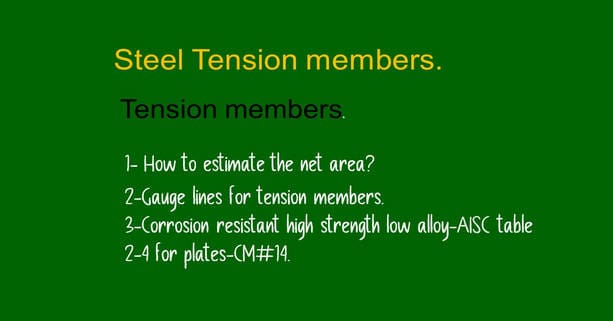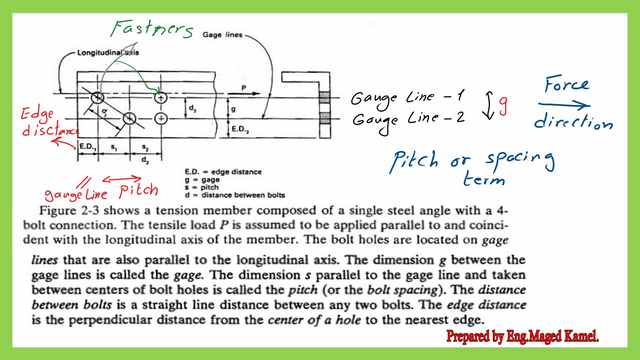Last Updated on April 27, 2024 by Maged kamel
Tension members-part 2.
In this post, tension members-part 2, we will check the different types of steel materials with varying grades and ASTM designations. It is critical to grasp the different types of materials.
In this post, we provide a study of AISC Table 2-4.
How do we estimate the net area of tension members?
The next topic concerns gauge distances if we have a single angle with four bolted connections arranged in two gauge lines.
Assume the applied force acts at the angle’s centroid. The first and second lines of fasteners are arranged in the same direction as the applied force.
The first and second gauge lines have two fasteners. The vertical distance between them is the gage distance, represented by the symbol g. It runs perpendicular to the direction of the force.
The inclined distance joining between the two fasteners, denoted as D1, has a horizontal distance in pitch distance S1, while the vertical distance component is gage g.
The edge distance, known as ED1, is measured from the center of a hole to the nearest edge. This value is the horizontal distance.
We can get the net width, which depends on the route of bolts; if our section is vertical, we will deduct the hole diameters from the vertical width depending on the number of bolts we face.
To get the net width while working with a zigzag line distance between the bolts, add S^2/4g, S is the longitudinal distance as a center-to-center spacing, where g is the transverse distance, and deduct the hole diameters for bolts that the section is cutting.
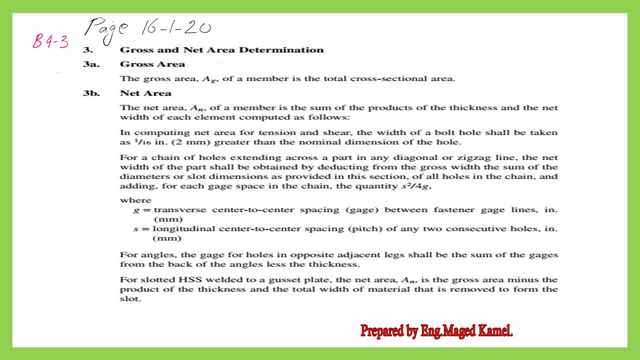
Applicable ASTM specifications for structural shapes- AISC Table 2-4.
Carbon steel-AISC Table 2-4 for various structural shapes-CM#14.
Carbon steel is classified into five categories, beginning with ASTM A36, ASTM A53 Grade B, and ASTM A500, which includes two grades: B and C.
ASTM A501 has grades A and B, followed by ASTM A 592 C, which has grades 50 and 55.
What are the preferred material parameters based on the marked black square?
A36 with Fy=36 ksi and Fu=58-80 ksi is ideal for M, S, Mc, and L shapes.
The preferred ASTM A for pipe is ASTM A 53 grade B, with Fy=35 ksi and ultimate stress Fu=60 ksi.
For round HSS, the preferred ASTM A is ASTM A 500 grade B with Fy=42 ksi and ultimate stress Fu=58 ksi.
For rectangular HSS ASTM A 500 grade B, Fy=46 ksi and ultimate stress Fu=58 ksi.
The gray squares are for other potential grades and can be utilized if requested. This comprises ASTM A500 grade C and ASTM A501 grades A and B for HS sections.
The white square for the material specification is not applicable.
High strength-alloy steel-AISC Table 2-4 for Various structural shapes-CM#14.
There are four groups, including ASTM A 572, with five grades for the high-strength alloy. Grade 50 is preferred for the HP section, with yield stress Fy=50 ksi and fu=65 ksi. We have the symbol d, meaning a maximum tensile strength of 70 ksi can be specified.
Also, we have symbol e for grades 60 and 65, for which grade 60 has yield stress Fy=60 ksi and ultimate stress Fu=60 ksi.
While grade 65 has a yield stress of Fy=65 ksi and ultimate stress of Fu=65 ksi, E is for flange thicknesses of less than or equal to 2 inches only.
ASTM A 618 f, with grade I and grade ii, with yield stress Fy=50 ksi and Fu=70 ksi, the symbol f stands for it can be specified as corrosion resistant.
ASTM A-913 comes in four grades; the first grade is 50 with Fy=50 ksi with symbol g, which indicates that the minimum Fy of 50 ksi is to be applied with walls nominally ¾ inches and Fu=60 with symbol h, which states that the ultimate stress can be raised to 65 ksi and a maximum yield to tensile stress strength ratio of 0.85 can be specified.
ASTM A 992, preferred for the W section, has yield stress Fy=50 ksi and ultimate stress Fu=65 ksi. Its symbol I stands for maximum yield to tensile stress strength ratio of 0.85. The carbon equivalent formula is mandatory in ASTM A992.
.
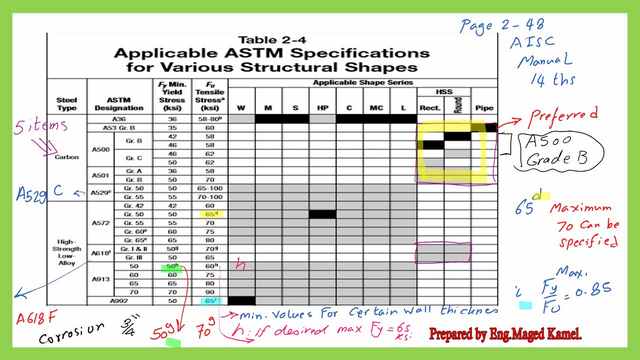
Corrosion-resistant high strength low alloy for various structural shapes-CM#14.
There are three categories of corrosion-resistant high-strength low alloys: ASTM A 242, grades 42, 52, and 60, and ultimate stress Fu from 63 to 70 ksi.
We have symbols j, K, and L. The symbols J, K, and L are related to the shapes with flange thickness. For j is for flanges with a thickness greater than 2 inches only.
The specified Fy equals 42 ksi, and the ultimate stress is 63 ksi. For K for the flange, the thickness is >1.5 inches and less than or equal to 2 inches only. The specified Fy equals 46 ksi, and the ultimate stress is 67 ksi.
L is for flanges with a thickness of less than or equal to 1.50 inches. The specified Fy equals 50 ksi, and the ultimate stress is 70 ksi. The second group is for ASTM A 588, with Fy=50 Ksi and Fu=70 ksi.
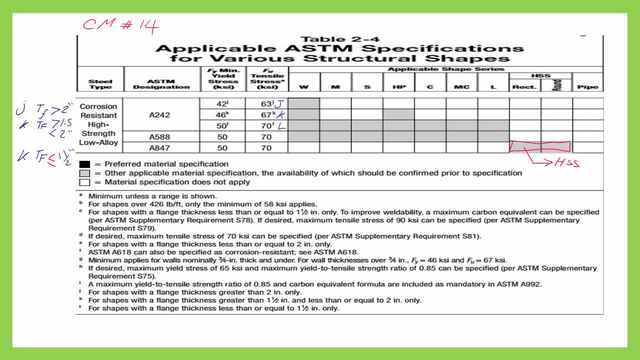
ASTM A572 contains five classes, ranging from 42 to 65; hence, the required grade must be given.
Practice problem for ASTM A24.
ASTM A 242 is specified for a beam with W24x192; it is required to find the yield stress Fy and Fu values for the beam and the modulus of elasticity; this practice problem is only given for CM#14. As a reminder, A242 was used as corrosion resistant in tables 2-4 and later removed from CM#14 for corrosion resistance; it was available for the W section and has a grey color.
Now, it is used for plates. Based on the flange thickness, it has three yield stress grades: 42, 46, and 50 ksi, marked J,k, and l.
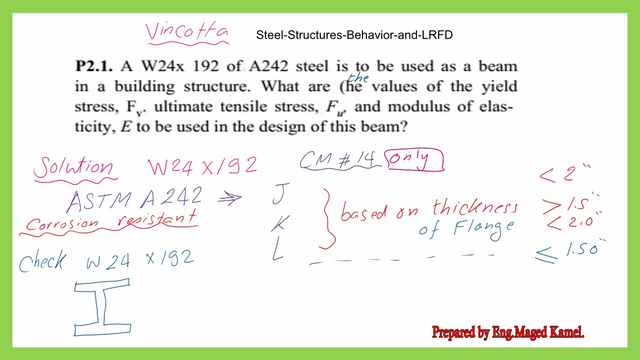
Based on Table 1-1, the flange thickness is 1.46 inches which is less than 1.50 inches, we will select grade 50 category L and the ultimate stress Fu is specified as 70 ksi. The modulus of elasticity is 29×10^6 psi.
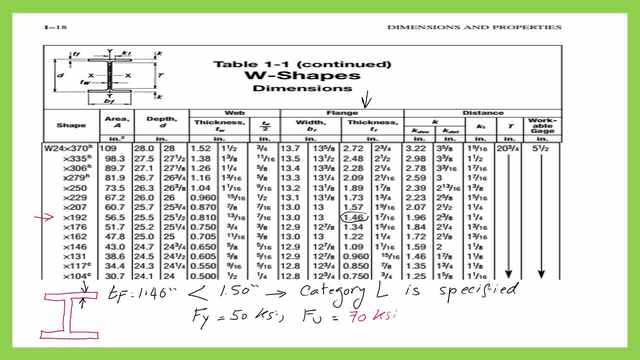
Results
Last Updated on April 27, 2024 by Maged kamel
Last Updated on April 27, 2024 by Maged kamel
#1. Find the gross and net area for a plate of 8x 3/4" with 7/8" bolt.
#2. What is the preferred grade for W sections?
#3. What is preffered grade for HSS pipe section?
The next post is a Review of AISC Tables 2-5 for plates.
For a useful external Chapter 3 – Tension Members– Bartlett Quimby

